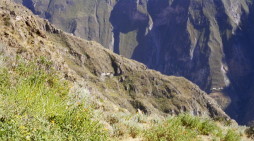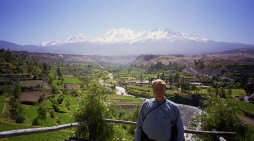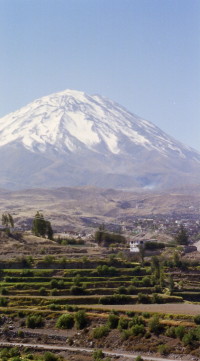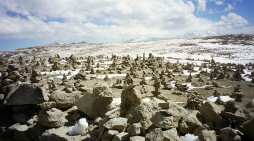
Photo.
Condors flying in Colca Canyon.
Hardly determined to see the condors, I started in
Peru's second largest city, Arequipa (7 July 2002). The city is located at an
altitude of 2,380 meters (7740 feet) above sea level, in the Peruvian
Andes.
Arequipa, the capital of department of Arequipa, is the most important city
of southern Peru. Arequipa has been strongly influenced by both Andalusian
and Spanish Colonial ideas and architecture, such as the Santa Catalina
Monastery, the Goyeneche Palace and the Casa del Moral.
Arequipa has many fine colonial-era Spanish buildings built of sillar, a
pearly white volcanic rock used extensively in the construction of the city,
from which it gets its nickname La Ciudad Blanca ("the white city"). UNESCO
declared the historical center of Arequipa as a World Heritage Site.
The year before I visited the city, it was badly damaged by an
earthquake of 7.9 on the Richter scale (the earthquake occured on 23 June
2001).
Just before I arrived in Arequipa, the city was in June 2002 completely
paralysed for a week by strikes and riots in protest of the privatization of two
regional electricity-generating plants. The demonstrations were seen as a
manifestation of increasing anti-globalization sentiments in South America. I
also heard that some people died in the demonstrations.
For me it was another great adventure in Peru
admiring Arequipa`s beautiful surroundings. So far I could see everything
seem to work normally now. From the city centre I could watch the volcano El Misti and other mountains.
|
Photo. Arequipa is surrounded by high snowy
peaks including volcanoes.
I guess it make even more exciting to live
here. |
 |
|
Photo. Arequipa is surrounded by high snowy
peaks including volcanoes.
The beautiful snowcap on the top lighten up the city when the sun
shines.
Only two weeks before I came here it had been violent
demonstrations.
Some people have been killed.
Fortunately it was quite when I arrived, and I could walk around
without feeling worried. |
 |
By car I and my travel companions
took our way high up in the Andean Highlands. On the road through
the Reserva Nacional Salinas y Aguada Blanca, we stopped to say hello to the Llamas
and other strange animals. Animals of the highlands include members of the South
American Camelids; the llama, alpaca, guanaco and vicuna.
The first two have bean domestic for thousands of yeas, while the latter who
are found only in the wild. We often watched Vicunas, and later we could see
llamas and alpacas. Guanaco is reportedly very seldom to find. The have almost
disappeared from the area.
Photos. Members of the South American Camelids; the llama,
alpaca, guanaco and vicuna.
Peru's many high mountains, volcanoes, and craters, are
very attractive among trekkers, hikers and mountaineers. Several places around
there is possible to find traces after the mighty Incas.
|
Photo. A cold stop at Vizcachani, 4150 metres
above ocean level. |
 |
The highest mountain nearby is
the snow capped Ampato, which rise 6380 metres high. So we continued on
the road trough bleak altiplano over the high point of about 4800 metres, where we
could admire more of the snow caps of Ampato.
We stayed one night in the Chivay, 160 kilometres from Arequipa. It's an
small Indian village high up in the mountain (3700 metres). Here the temperature
was far beyond zero in the late evening and night, but that didn't frighten me
from taking a bath in the thermal hot springs nearby.
The Indians wear traditional, colourful embroidered clothes, especially their beautiful
hats as the most distinctive. I could hear that they were expert of
playing Inca wind instruments. They blew in their typical panpipes as
best they could, and out it came beautiful tones.
I was gripped by the intense music and unique atmosphere. The locals played
on the common Quena (kena), a flute made of mambo, and other kind of flutes.
They also used typical instruments as Bombo (drum) and Charango (string
instrument). Together they sounded as an perfect orchestra for party (fiesta)
music. It was really great!
|
Photo. Dancing wildly with the Indians in
Chivay, at an altitude of about
3700 metres (also displayed digitally on video). Here we see the fantastic
orchestra. |
 |
It's the capital
of the province of Cailloma. Later in the evening I was invited to
join them in a dance, which I couldn't refuse. It was called Tutsjo (Titiua) or
something. There are as many as 300 varieties of traditional dances in Peru, and
I assume that this peculiar dance was a speciality.
Even thought I felt well, the locals danced a special dance for healing a
sickness. I just moved around without knowing too much of the dance.
My
guide Marianno said afterwards that I looked like a bird when I danced. Perhaps you thought
you were a condor, he said. It was really heavy to breath in the thin
air here, but so far I keep my breath.
I really wonder what kind of sickness they did try to
cure for, because in the middle of the dancing show I was told to lay down on
the floor. An Indian woman stood over my face, and suddenly she lifted up her
skirt and almost sat down over my head. Then I got really problems with
breathing and I nearly lost my breath. And I am sure many wonder: what did I
actually see under her skirt?
This article continues in part 2: read about the big, majestic
condors.
Stein Morten Lund,
11 October 2002
Additional
information
Some facts about the country:
·
Formal country name:
Republic of
Peru.
·
Area: 1.28 million sq km.
·
Population: 28 million.
·
People: 54% Indian, 32% Mestizo (mixed
European and Indian descent), 12% Spanish descent, 2% Black, Asian
minority
·
Language: Aymara, Quechua, Spanish;
Castilian.
·
Religion: Over 90% Roman Catholic, small
Protestant population.
·
Government: constitutional
republic.
Read more
about Peru
on our website:
·
Visit the ancient Inca capital of
Cuzco,
·
Explore the lost city of
Machu Picchu.
·
Study the enigma of the Nazca Lines. What
is really the purpose of these lines?
·
Experience the country`s beautiful
scenery, the Peruvian Andes.
·
Visit home to some of the millions of
highland Indians who still speak the ancient tongue of Quechua and maintain a
traditional way of life.
·
Get an adventure of life in the
Amazon
Basin, which
occupies half of Peru. Look
up for the puma!
Read more about Peru on this website: people, Amazon
jungle, cultural and archaeological treasures, and more.
